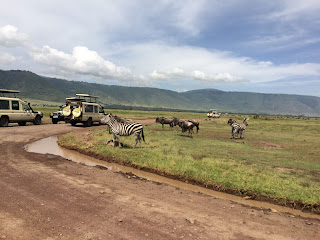At the end of the 2017-2018 school year, I was successful in achieving a promoted post. As the CAS (Creativity, Activity, Service) Coordinator, a major part of my role is planning the Grade 11 service trip to Tanzania during the February half term break.
This involved a lot of headache: conversations with the PTA; trips to the Tanzanian High Commission; being logistical commander to the 30 students preparing, fundraising and attending the trip. Planning started in September and by February, after several small snafus (a student who had a severe allergic reaction to the malaria tablets the morning of the flight, parents concerned about the terror threat, paperwork, paperwork, paperwork) the 29-student, 4-teacher group made our way to the airport.
Our first hurdle was an immense one. We flew Air Kenya from London to Nairobi and then from Nairobi to Moshi. Our connecting flight, the latter one, had been cancelled and our group had been rebooked onto two separate flights: one at 8am and one at 5pm and the teachers had all been booked onto the later flight. After two hours at the counter, three phone calls to school and an incredibly kind Air Kenya staff member, we all got bumped onto the earlier flight. It seems simple but it was a hell of a lot more stressful than this.
Perhaps because of the initial stress, and perhaps because travel with teenagers is not without its drama, the outward journey was a bit hairy. First, 15-minutes into the flight one of the students decided it was a good time to break up with his girlfriend, literally on the airplane. By the end of the flight, he was with someone else. This caused knock-on drama for the rest of the trip. Next, when we arrived in Nairobi, I decided to leave my brain and all of the paperwork, including our baggage claim tags, on the plane. This ensured that I got a free tour of the wider Nairobi airport, including the back workings of the luggage processing and handling. Because that wasn't enough, I then proceeded to lose the baggage claim tags while going back through security and had to have another lovely Air Kenya official re-print them all. Honestly, hot mess.
Fortunately, a majority of the trip's drama seemed to take place at the airport (more drama upon the return involving a student leaving a passport on the plane, me losing and eventually finding my Fitbit, and an unfortunate digestive incident with a milkshake...). But hopping on our little propeller plane to Moshi yielded a beautiful view of Africa's tallest peak:
And when we eventually arrived at our accommodation, a short walk from the primary school we would be working at for the week, Kilimanjaro sat up pretty. It's the best way view for a morning coffee.
Once the actual service part of our trip started, issues ironed themselves out nicely. The group made its way to a local primary school where we became construction dogsbodies: painting walls, breaking up and laying cement, fixing furniture, etc.
Teachers and students at the school itself were very welcoming. They've had a lot of international support and were quite used to foreigners invading their space with construction tasks. The volunteering itself definitely brings up questions around sustainability, many of which I still have. But where possible, we tried to support the local community--we hired roofers who were local contractors and brought fundraising money to buy supplies with local businesses. Definitely imperfect but something I'll work on for next year's trip.
The school building was one typical to local climates; all classrooms faced into a central courtyard and windows were not covered.
Little grammatical gems like this also lined the outer walls.
And students had the opportunity to get into classrooms and practise some teaching skills, see how challenging it really is. With class sizes of 40-50, it was an eye-opening experience. Various other experiences over the week really made our students check their privilege; walking to the local spring to collect water, a 30-minute round trip walk away for instance, really made them consider their daily £10 spend on lunches.
It also made going into the city quite powerful. We took a small group of students into Moshi centre to buy grain with part of our fundraising money. Central Moshi is hardly huge but there is an international school if anyone is keen:
The money spent on grain ensured that the school's grain silo would be full and able to provide school lunches for all students for the academic year. At the start of the week, the Headteacher wanted to thank us for last year's contribution; ensuring school lunches for all had seen a significant increase in students' exam results. And parents in the local community who were financially able to continued to contribute to the school lunch fund.
The hundreds of kilos of grain arrived at school few hours later where staff and students alike formed a gigantic bucket brigade to fill the silo. Surplus grain went into a storage classroom and spilled grain was scooped up into buckets and made its way back into the bags. Nothing was left to waste.
At the end of our five days of volunteering, the school thanked us with a whole-school assembly. This involved lots of singing, dancing and clapping. I'd like to believe that it reminded my students that we're not all that different. And although I still have questions about how we turn this trip into something less Voluntouristy, it was clear to see that many of our actions did leave a positive impact.






































